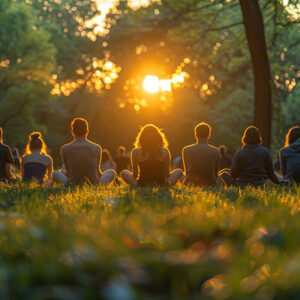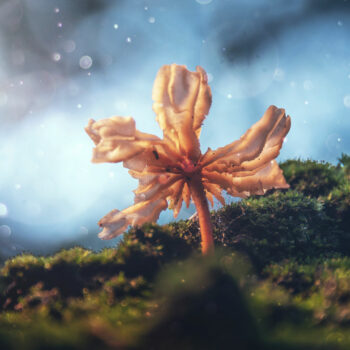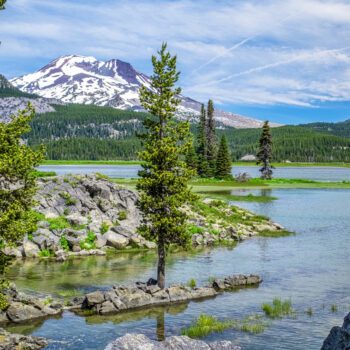Ayahuasca Retreats
Ayahuasca retreats allow one to delve into the limits of consciousness. Let’s explore the advantages and disadvantages of this sacred brew.

The psychedelic journey is an extraordinary experience. And for good reason, there is nothing ordinary about feeling heightened emotions or experiencing a grand and bizarre inner film that no one else can witness. The name Ayahuasca alone carries a promise of mystical adventure in the great tradition of the Amazonian peoples.
But beyond the clichés, Ayahuasca is a fascinating brew whose potential therapeutic effects have led to the creation of specific retreat centers. However, it is important to note that this substance remains illegal in a large part of the world.
What is Ayahuasca?
In the Quechua language, Ayahuasca means “vine of the souls” or “vine of the dead.” This name, albeit not very inviting, is explained by the belief that it has the power to connect worlds. According to stories, Ayahuasca is like a botanical version of the pill that allows Neo, the main character in the movie “The Matrix,” to access the reality of the world around him.
Contrary to what it may seem, Ayahuasca is not a plant but a herbal concoction made from several plants. The Banisteriopsis caapi, which grows in Peru, Bolivia, Brazil, Venezuela, Panama, and Colombia, is the main ingredient that imparts its hallucinogenic and empathogenic properties to the mixture. It is often combined with Psychotria viridis, another plant that contains a psychoactive molecule called DMT.
The brew has various names depending on the country, such as yagé (in the Tukano language) or natem (in the Jivaro language). Within the Amazon rainforest, other varieties are also found, such as Banisteriopsis inebrians, Banisteriopsis muricata, or Banisteriopsis rusbyana.
A Continuing Story
Following excavations in Ecuador, archaeologists estimate that the transformation of vines to produce Ayahuasca dates back at least to 2000 BCE.
It is through the observation of rituals and religions still practiced today by several Amazonian peoples (such as the Cofán, Cocama, or Marubo) that modern Westerners have gained knowledge about this plant. Even outside the Amazon rainforest, several spiritual or religious movements incorporate Ayahuasca into their faith. The growing interest of Westerners in magical rites related to well-being has transformed into a trend, sometimes disconnected from any cultural grounding, in places like Silicon Valley or San Francisco. As depicted in the satire film “While We’re Young” with Ben Stiller and Adam Driver, the initiation ceremony practiced by Westerners can sometimes appear superficial or ridiculous.
The Ritual Use of Ayahuasca
As one can imagine, this powerful hallucinogen is one of the many specialties of shamans. In the form of a sacred drink, the plant is central to ceremonies with social, therapeutic, divinatory, and even sorcery purposes.
Its potent effect promotes shamanic trance and self-exploration by stimulating serotonin receptors in the brain. Ayahuasca can induce diverse visions, similar to daydreams, as well as impressions of lingering light and alterations in visual or auditory perception.
In indigenous beliefs, the preparation is believed to facilitate communication with the supernatural world, granting access to a comprehensive reality encompassing the earthly realm and the realm of spirits.
The Therapeutic Use of Ayahuasca
Within Amazonian populations that utilize Ayahuasca, the plant plays a role in aiding the diagnosis of physical or psychological ailments.
In the traditional ritual, the shaman uses the substance, alone or with the patient, to enter into a trance. Through it, the healer may access a hidden reality to identify the causes of the patient’s suffering. In shamanic tradition, the causes of illness are generally attributed to the presence of a spirit – organ-devouring spirits or disgruntled entities punishing the individual. It may also be that the patient’s soul has left their body and needs to be reintegrated.
Based on the information gathered during their psychedelic journey, the shaman then employs other non-hallucinogenic plants to treat and assist the patient.
Ayahuasca Retreats : Spiritual or Therapeutic Retreats?
Originally, shamanic ceremonies accompanied all aspects of personal and social life. Shamans could assist in healing an individual as well as seek the benevolence of spirits for a good harvest.
In Ayahuasca retreats, the objective is different. Firstly, because these retreats cater to individuals outside of indigenous beliefs – the heirs of pre-Columbian traditions do not require participation in a retreat! Participants do not seek a reflection of their ethnic or cultural roots; rather, they seek personal benefits. In any case, they are in search of a form of well-being.
Some people come to actualize their beliefs and hope that the botanical mixture will enable them to connect with other realms. Whether they follow Hinduism, Buddhism, a holistic worldview, or Mama Ayahuasca, they are seeking to deepen their spirituality.
Conversely, other participants come seeking the relaxing effects of Ayahuasca, much like psilocybin retreats.
The Effects of Ayahuasca
Physiological Effects
Taking Ayahuasca is generally not a pleasant experience. The taste of the brew is acrid and bitter, quite unpleasant to the palate. Shortly after ingestion, the first effect is felt: nausea, sometimes followed by vomiting or diarrhea.
These side effects are particularly linked to the primary function of the preparation. In fact, in traditional South American medicine, it is a powerful purgative that aims to cleanse the body and combat parasites. Once again, local shamans explain these parasitic infections as the presence of a spirit to be purged.
Psychedelic Effects
That covers the gastrointestinal aspect; it’s better to be comfortable with the subject before booking an Ayahuasca retreat.
The question of the spiritual journey is undoubtedly more intriguing. The psychedelic effects of DMT involve the appearance of phosphene phenomena (persistent flashes of light in the visual field), alterations in sensory perception, increased creativity, and hallucinations. Sensations of euphoria or fear can also accompany these effects.
In practice, these manifestations give rise to powerful interpretations: dreams or visions. They are described as the source of heightened awareness and an opening to the world. It is a powerful, bewildering, and symbol-rich adventure.
The challenges encountered during the intensity of the DMT experience are perceived as personal obstacles to be overcome and conquered. In this regard, Ayahuasca is often described as a potion with positive effects that offer a revelation of one’s true self, without armor. Like several other psychedelic substances, it is believed to provide a fresh start or initiate a life change.
The Importance of Setting
The environment surrounding a participant in a psychedelic ceremony is a crucial element for the success of the experience. Without personalized preparation and vigilant presence during the psychedelic journey, it is possible to experience dreadful sensations: nightmares, feelings of suffocation, paranoia.
A shaman or facilitator must therefore engage with the participant over time and assist them in addressing the themes they wish to explore. The professional is also there to intervene in case of negative effects or psychological distress. Hence, the consumption of psychedelics, especially DMT, should not be undertaken without expert supervision.
Enjoy a 100% legal psilocybin experience in the Netherlands
Preparation and retreat in English
Enjoy a legal & intense experience in the Netherlands
A psychedelic retreat designed for best results. Small group, one-to-one preparation, experimented facilitators, 1 year monthly integration & awesome place !
Join us

Scientific Research and DMT
Several research studies have suggested that the plant preparation may have benefits for psychological well-being, depression, anxiety, and addiction treatment.
In a study involving a sample of 57 individuals, researchers concluded that Ayahuasca could have a favorable and immediate impact on depression levels, stress, and creativity experienced by the subjects. These effects were still significant four weeks after the experience.
Another publication suggests that a single dose of the Amazonian shamanic mixture significantly reduce depression symptoms compared to a placebo in patients resistant to conventional antidepressant treatments.
Likewise, a study on the potential therapeutic effect of DMT on addiction to tobacco, alcohol, cocaine, cannabis, or opioids found a significant decrease in consumption for the first three substances. Participants in this scientific protocol on addiction reported positive and lasting changes, including empowerment and overall well-being.
Legality of Ayahuasca
The legality of psychedelics can complicate personal desires for individuals who wish to act in accordance with the law. Spain and Portugal were the first Western countries to come into contact with traditional populations during the conquest of Latin America in the 15th century. As a result, only Spanish- and Portuguese-speaking countries offer Ayahuasca retreats, linked to the historical context and ritual use of the vine. However, the legality of these retreats varies among different territories.
The Legality of Ayahuasca in the Americas
The decoction is primarily legal across the American continent, for example in Mexico, Brazil, Costa Rica, or Peru. This situation can be attributed to the presence of populations still connected to indigenous practices. The use of Ayahuasca is recognized in these countries as an important cultural relic of our history that needs to be preserved.
Further north, the United States government permits the consumption of ayahuasca within the context of religious rituals under the 1993 Religious Freedom Restoration Act. Some cities have even decriminalized the plant mixture beyond religious communities (such as Seattle, Oakland, or Washington DC).
The Legality of Ayahuasca in Europe
Spain exclusively allows the use of the vine in pharmacological preparations, and Portugal has decriminalized its use (but not sale or cultivation). However, it’s important to note that the plant itself is not legal in either of these countries.
Contrary to what may be inferred from certain psychedelic retreat offerings, Spain or Portugal do not permit its sale, transportation, or preparation. Companies offering this type of retreat may not be able to provide the same level of protection to participants as in countries where the use is completely lawful.
Safety of Ayahuasca Retreats
In practice, it is Peru, Mexico, and Costa Rica that offer the most legally recognized ayahuasca retreats. In these territories, consumption or sale does not pose any legal risk to participants or organizers.
However, Latin American countries may face political instability, corruption, and sanitary facilities that may not meet the expectations and needs of a population from Europe or North America. Like any psychedelic experience, an ayahuasca retreat can entail certain risks, such as minor injuries, episodes of paranoia, or aggressive participants.
Of course, ayahuasca retreat teams are capable of managing delicate situations and ensuring participant safety. However, it is advisable to embark on this adventure with a clear understanding of the advantages and limitations of the country where it takes place.
Key Takeaways of Vine Consumption
The experience of the “vine of the dead” (apologies for emphasizing the name!) is profound and can often be transformative. However, it requires careful consideration in terms of selecting the setting, guidance, and the individual’s own experience.
At this stage, research on the plant is still limited to draw definite conclusions about the benefits and risks associated with its ingestion. Nonetheless, it is desirable for science to continue to explore this subject in order to provide more alternative possibilities for addressing mental health.
Image de alexeyzhilkin sur Freepik
Last updated on 10 October 2024





